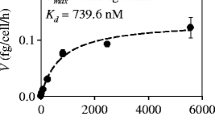Abstract
The effects of cadmium on the growth and respiration of two strains of Bacillus subtilis are compared to the accumulation of Cd by viable and cyanide-killed cells, protoplasts and cell fractions of the strains. Growth and respiration of strain 1A1 were significantly inhibited at 10μg Cd2+/ml while the growth and respiration of strain 1A1R, a selected mutant of 1A1, were only slightly affected. Similarly, 1A1R protoplasts were more resistant to Cd than were 1A1 protoplasts. The differential resistance of the strains correlates with the accumulation of Cd by the two strains, with 1A1 accumulating approximately 10 times the level of Cd after a 4 h exposure to 1 μg Cd2+/ml. The distributions of Cd throughout the cells, however, were similar between strains. Based on the accumulation of Cd by cyanide-killed protoplasts, uptake of Cd by 1A1 appears to be an active process, while for 1A1R, Cd accumulation is independent of protoplast viability.
Similar content being viewed by others
Abbreviations
- SMM:
-
Subtilis Minimal Medium
- AAS:
-
Atomic Absorption Spectrophotometry
- TSA:
-
Trypticase Soy Agar
- PCA:
-
Plate Count Agar
- INT:
-
2-p-iodophenyl-3-p-nitrophenyl-5-phenyl-2H tetrazolium chloride
- dd H2O:
-
double distilled demineralized water
- OD:
-
Optical Density
References
Aiking H, Kok K, van Heerikhuizen H, van't Riet J (1982) Adaptation to cadmium by Klebsiella aerogenes growing in continuous culture proceeds mainly via formation of cadmium sulfide. Appl Environ Microbiol 44:938–944
Bitton G, Friehofer V (1978) Influence of extracellular polysaccharides on the toxicity of copper and cadmium on Klebsiella erogenes. Microb Ecol 4:119–123
Chopra I (1971) Decreased uptake of cadmium by a resistant strain of Staphylococcus aureus. J Gen Microbiol 63:265–267
Chopra I (1975) Mechanism of plasmid-mediated resistance to cadmium in Staphylococcus aureus. Antimicrob Agents Chemother 1:8–14
DeFilippis LF, Hampp R, Ziegler H (1981) The effects of sublethal concentrations of zinc, cadmium and mercury on Euglena II. Respiration, photosynthesis and photochemical activities. Arch Microbiol 128:407–411
Edgar NF, McDonald KO, Burke WF (1981) Plasmid curing in Bacillus subtilis. FEMS Microbiol Lett 12:131–133
Gray O, Chang S (1981) Molecular cloning and expression of Bacillus licheniformis β-lactamase gene in Escherichia coli and Bacillus subtilis. J Bacteriol 145:422–428
Hadzija O (1974) A simple method for the quantitative determination of muramic acid. Anal Biochem 60:512–517
Herbert D, Phipps PJ, Strange RE (1971) Chemical analysis of microbial cells. In: Norris JR, Ribons DW (eds) Methods in Microbiology Vol 5B. Academic Press, London, pp 209–344
Horitsu H, Kato H (1980) Comparisons of characteristics of cadmium tolerant bacterium Pseudomonas aeruginosa G-1 and its cadmium tolerant mutant strain. Agric Biol Chem 44:777–782
Kahn HL, Peterson GE, Schallis JE (1968) AA micro-sampling with the sampling boat technique. Atomic Absorption Newsletter 7:42–45
Khazaeli MB, Mitra RS (1981) Cadmium-binding components in Escherichia coli during accommodation to low levels of the ion. Appl Environ Microbiol 41:46–50
Korkeala H (1979) The distribution of cadmium between cellular subfractions in cadmium sensitive and cadmium resistant Staphylococcus aureus. Acta Vet Scand 41:438–446
Kremer BD, Markham JW (1982) Primary metabolic effects of cadmium in the brown alga Laminaria saccharina. Z Pflanzenphysiol 108:125–130
Kurek EJ, Czaban J, Bollag JM (1982) Sorption of Cd by microorganisms in competition with other soil constituents. Appl Environ Microbiol 43:1011–1015
Lighthart B (1980) Effects of certain species on pure and litter populations. Antonie van Leuwenhoek J Microbiol Serol 46:161–167
Mitra RS, Bernstein IA (1977a) Nature of the repair process associated with the recovery of Escherichia coli after exposure to Cd2+. Biochem Biophys Res Commun 74:1450–1455
Mitra RS, Bernstein IA (1977b) Single strand breakage in DNA of Escherichia coli exposed to Cd2+. J Bacteriol 133:75–80
Mitra RS, Gray RH, Chin B, Bernstein IA (1975) Molecular mechanisms of accommodation in Escherichia coli to toxic levels of Cd2+. J Bacteriol 121:1180–1188
Novick PR, Roth C (1968) Plasmid-linked resistance to inorganic salts in Staphylococcus aureus. J Bacteriol 95:1335–1342
Olafson RW, Abel K, Sim RG (1979) Prokaryotic metallothionein: preliminary characterization of a blue-green alga heavy metalbinding protein. Biochem Biophys Res Commun 89:36–43
Olafson RW, Loya S, Sim RG (1980) Physiological parameters of prokaryotic metallothionein induction. Biochem Biophys Res Commun 95:1495–1503
Perry RD, Silver S (1982) Cadmium and manganese transport in Staphylococcus aureus. J Bacteriol 150:973–976
Pickett AW, Carter IS, Dean ACR (1976) Enzymatic activities of cadmium- and zinc-tolerant strains of Klebsiella (Aerobacter) aerogenes growing in glucose-limited chemostats. Microbios 15:105–111
Pickett AW, Dean ACR (1976) Cadmium and zinc sensitivity and tolerance in Klebsiella (Aerobacter) aerogenes. Microbios 15:79–91
Remacle J, Houba C (1980) The influence of cadmium upon freshwater saprophytic bacteria. Environ Technol Lett 1:193–200
Robinson J, Cooper JM (1970) Method of determining oxygen concentrations in biological media suitable for calibration of the oxygen electrode. Anal Biochem 33:30–339
Stacey KA (1968) Transformation. In: Clowes RC, Hayes W (eds) Experiments in Microbial Genetics. Blackwell Sci Publish, Oxford, England, pp 46–51
Tynecka Z, Gos Z, Zajac J (1981a) Reduced cadmium transport determined by resistance plasmid in Staphylococcus aureus. J Bacteriol 147:305–312
Tynecka Z, Gos Z, Zajac J (1981b) Energy-dependent efflux of cadmium coded by a plasmid resistant determinant in Staphylococcus aureus. J Bacteriol 147:313–319
Walker CW, Houston CW (1981) Toxicity of cadmium to bacteria. Biotechnol Lett 3:437–442
Zimmermann R, Iturriaga R, Becker-Birck J (1978) Simultaneous determination of the total number of aquatic bacteria and the number thereof involved in respiration. Appl Environ Microbiol 36:926–935
Author information
Authors and Affiliations
Rights and permissions
About this article
Cite this article
Surowitz, K.G., Titus, J.A. & Pfister, R.M. Effects of cadmium accumulation on growth and respiration of a cadmium-sensitive strain of Bacillus subtilis and a selected cadmium resistant mutant. Arch. Microbiol. 140, 107–112 (1984). https://doi.org/10.1007/BF00454911
Received:
Accepted:
Issue Date:
DOI: https://doi.org/10.1007/BF00454911




